Today I’ll tell you part 2 of the Sakuragaike Legend (and nanafushigi!). What was waiting at the bottom of the lake? Why was the snake-dragon suffering and how did his old follower help him? Where is Kouen Ajari The Snake-Dragon now?
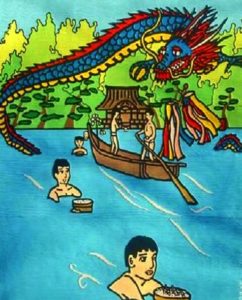
I’m Thersa Matsuura and you’re listening to Uncanny Japan. Do you remember where we were two weeks ago? Talking about the legend of Sakuragaike/桜ガ池 where eight hundred years ago a very high level monk, Kouen Ajari, decided he wanted to meet the future Buddha and ask a bunch of questions. His followers found him an out-of-the-way lake just down the road from me, called Sakuragaike. He turned himself into a daija, a kind of snake dragon, floated on over, and took up residence in the bottom of said lake.
Years later, one of his deshi/弟子 [which you’ll remember means apprentice or follower] a man named Hounen, and three of his deshi traveled to Sakuragaike, 300 kilometers away to visit their old master. There they sat in the grass by the water and chanted until Kouen-sama appeared in his old human form sitting atop a bunch of roiling smoke.
Kouen Ajari was very pleased to see his old deshi. So he parts the waters and invites the four of them down, down, down to the bottom of the lake.
Oh, no, what are they going to find?
Hey hey, how are you? I want to thank everyone who sent their favorite Kyoto and Nara places to visit. I was really touched and excited by the responses. I’m leaving in less than a week and am madly trying to fit everything in.
Okay, back to part two of the Legend of Sakuragaike.
What’s at the Bottom of Lake Sakuragaike?
When Hounen and his three deshi reached the very bottom of the deep lake they found a gorgeous temple.
”Wow!” Hounen said. ”I didn’t expect to see this.”
The five men sat around and talked about all manner of things, about Buddha’s teachings about past times. Time just flew by. Kouen remained in his human form the whole time.
As the day grew short Hounen said to his old master, again, I’m paraphrasing here.
“Master, it’s said that anyone who recites the name of Buddha will be granted the path to the Buddha’s beautiful paradise. So why, I wonder, would you not choose that instead of suffering in the form of a giant snake-dragon at the bottom of this lake for 5,670 million years just to meet the future Buddha?”
To which, Kouen-sama replied. “I made a promise with the future Buddha and myself, and I can’t quit now. But please continue to teach that to all the people you see on earth. It’s a good teaching.”
“Well, I guess we must be going now,” Hounen said. “But Kouen-sama, could I ask a small favor of you, a kind of souvenir, it you’d like.”
“Sure, what’s that?”
“Could we see your other form, the giant snake-dragon body? That would be really cool,” again paraphrasing.
Kouen Ajari Shows His Snake-Dragon Body
Kouen Ajari laughed and said, “As far as souvenirs go, that’s pretty cheap. Of course, no problem at all.”
He nodded and once again black smoke gathered, above the lake, the temple, inside the temple. After a few minutes, they something shiny moving in the distance. Scales. The smoke cleared a little and there floating above them was the biggest, scariest looking daija they had ever seen. If they’d ever seen one, that is.
The three deshi were so frightened they buried themselves in dirt. The creatures eyes looked like a bunch of mirrors all reflecting into one another. It had a long, red tongue, and exhaled puffs of fire. It also had two long sharp fangs, needle-like whiskers, and pointy nails on its little dragon hands.
The Three Fevers/San Netsu
After he regained his composure, Hounen said, “Master, you are certainly a very formidable creature. But it’s said that both daiji, big snakes and dragons suffer from a thing called san netsu/三熱 or three fevers. Is this true?”
I need to interrupt our story one little second because I had never heard of this either, this Three Fevers. But it’s a thing. A Buddhist thing, actually. So this thing called san netsu or three fevers is believed to anguish all giant snakes and dragons.
The san netsu are:
1. Being burned to the marrow by hot air or hot sand.
2. A bad wind blows and the creature loses its home or its skin
3. Being eaten by a konjichou/金翅鳥 or karura — also Japanese or you might be familiar with the garuda. A garuda is a bird-like (often resembling an eagle) from Hindu mythology. The garuda can also be found in Buddhism and Jainism, but the important thing to note is that the garuda’s enemy is the nāga, a very smart serpent or dragon-like creature.
Getting Rid of the Parasites
Back to Kounen Ajari. After hearing the question about the san netsu, the enormous snake-dragon’s eyes welled up with hot tears and it said.
“Yes. It’s true. I have 64,000 scales on my body. And under these scales are 64,000 small insects that are always burrowing into my flesh, night and day. The pain is constant and intense. It is indescribable.”
“I think Buddha can help you with your problem,” Hounen said to the hovering snake-dragon. “Could you come down here a little closer?”
The daija slipped off its cloud and slithered through the air down to where Hounen and his deshi were standing, no longer cowering in the dirt.
Hounen took out some crystal juzu prayer beads and began to recite the Buddha’s name: Namu amidabutsu/南無阿弥陀仏. Namu Amida Butsu. He did this while walking around the giant creature three times. After his last time, all the scales from the dragon shook and fluttered away like the leaves from an autumn tree. The bugs and the pain were also gone.
“Thank you,” Kouen Ajari said. “If anyone could have helped me, it could only have been you.”
And in a poof of smoke the daija disappeared. The smoke was gone, too. The lake was serene. And Hounen and his deshi were standing on the grassy shore again.
The Legend Today
To this day it’s believed that there lives deep in the Sakuragaike lake an enormous daija, the great monk Kouen Ajari, waiting patiently for the Miroku Bosatsu, the future Buddha to show up so he can return to his human form and ask some questions.
Also to this day, in September during the autumnal equinox there is a ceremony performed to help appease, honor, and recognize the large serpent living at the bottom of the lake. The ceremony is involved but the gist of it goes something like this: a lot of sekihan is cooked for the snake dragon. Sekihan means red rice and while there are different recipes its a mixture of regular rice and mochi rice cooked with red adzuki beans. Sekihan is very often eaten on special occasions. Birthdays, anniversaries, some holidays, things like that.
So this sekihan is put into a bunch of hitsu. Remember hitsu from the Kokkuri-san episode? It’s a container made from strips of bamboo or wood. The nice ones are really nice and very often they are made to contain rice.
The ceremony starts. There are Shinto priests chanting, blowing flutes, and ringing bells while a bunch of young men donned in fundoshi (those white loincloth things you see worn during festivals) all line up, each one holding one of the ohitsu filled with 3 kilograms of sekihan. Almost seven pounds of rice.
Then one at a time they swim out to the middle of the lake and sink the offering under the surface. I’m really not sure how they do this. I’ve watched videos and it looks like they push it down, then use their feet to further sink it. Somehow it stays down. I mean when they’re swimming out there, the containers look to be buoyant. They’re floating on the surface. So I don’t know. But every single hitsu filled with rice goes down, stays down, and the young man swims to the other shore. The next boy then swims out to do the same thing until all the containers of rice have been sunk and disappeared.
A few days later the ohitsu containers will float to the top empty. Our very patient and no doubt hungry Kouen Ajari dragon has eaten the rice! That’s not all. Here is where the nana fushigi comes in. As if the whole monk turns himself into a dragon wasn’t strange enough.
In the past, occasionally one of the ohitsu containers ends up in a lake in Nagano. Just an idea how far that is away, it would be about a four hour drive. So some believe that the lakes are connected by some very deep underwater tunnel.
Which could be because there are also stories from long ago about how there were many efforts made to measure the depth of the lake, but they all failed. Like, the line they were using would always get mysteriously cut. Or the weight they were using would always fall off. Or over the years the men who went out to measure would suffer some ill luck after having tried.
So that’s another strange fushigi thing about the lake.
And that’s it. That’s the legend and the nanafushigi story, Sakuragaike.
Only one more month of 2021. Richard and I have a couple things up our sleeves for 2022, so keep an eye open or ear out for those. I’ll give more details next month.
Until then, thank you for listening and thank you patrons for your support and being so incredible wonderful. I think Richard and I are going to do a couple osechi ryori recipes in December. Remember Episode 45 where I talked about osechi and New Year’s food and its meanings? Well, the plan is to each pick one (two?) recipes and put them up for patrons. What to choose? What to choose.
Okay, talk to you all real soon, bye bye!
Credits
Intro and outro music by Julyan Ray Matsuura
Electro Storm by Mikael Hellman
Link: https://filmmusic.io/song/8463-electro-storm
License: https://filmmusic.io/standard-license

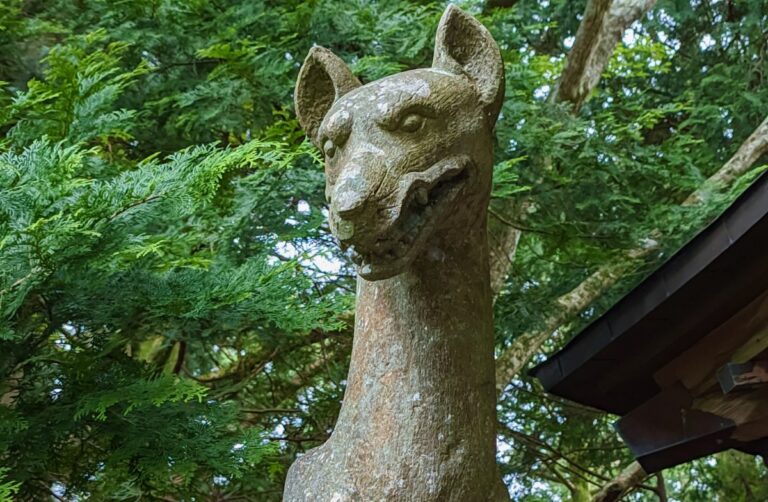
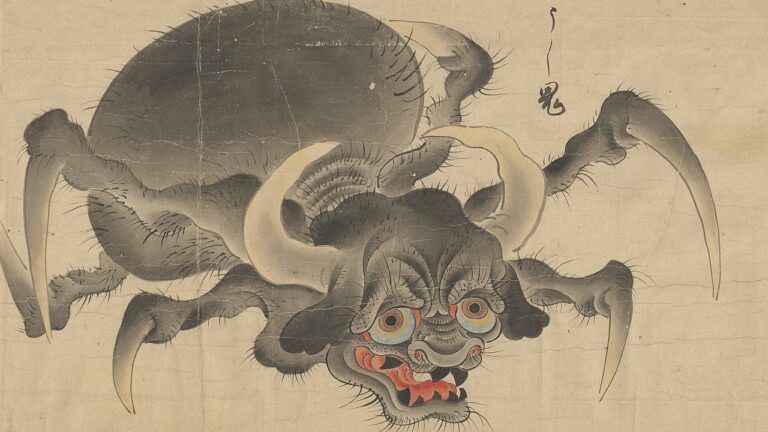
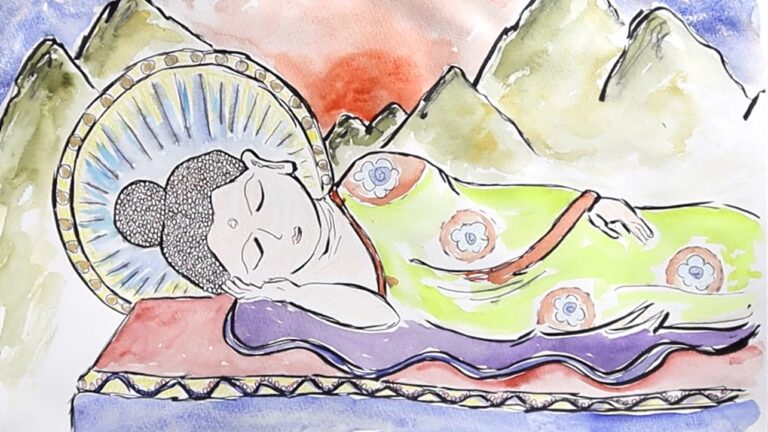
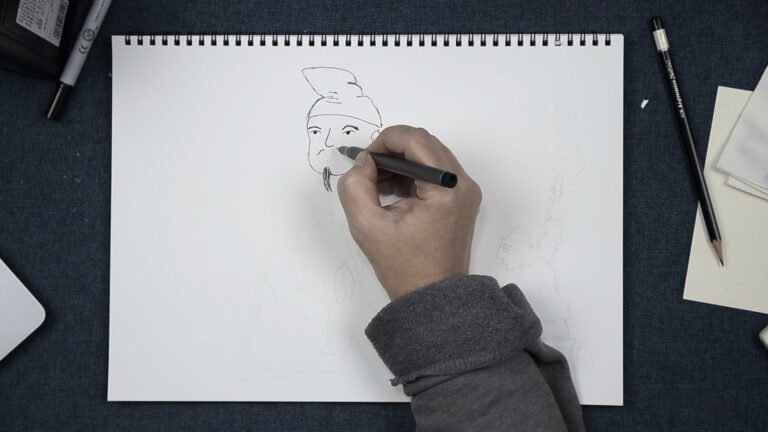


It’s been awhile since I studied indigenous folklore from my neck of the woods in the Upper Great Lakes region, but they also had a sky bird versus water serpent dynamic running through their belief systems, too. It must be a very, very old story.